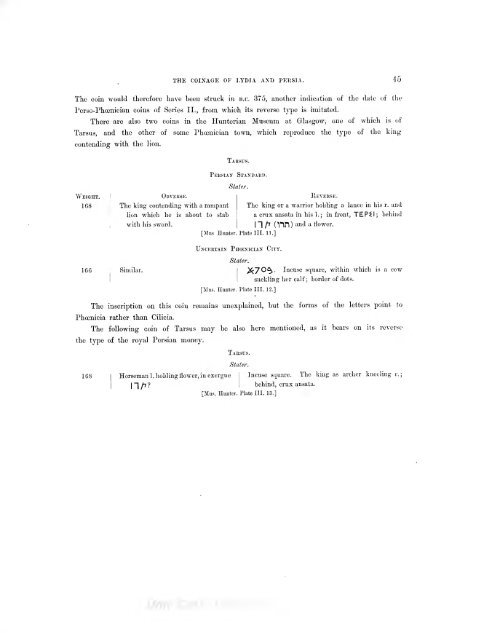NUMISMATA ORIENTALIA. - Forvm Ancient Coins
NUMISMATA ORIENTALIA. - Forvm Ancient Coins
NUMISMATA ORIENTALIA. - Forvm Ancient Coins
Create successful ePaper yourself
Turn your PDF publications into a flip-book with our unique Google optimized e-Paper software.
THE COINAGE OF l.YDIA AND PERSIA. 45<br />
The coin would therefore have been struck in b.c. 375, another indication of the date of the<br />
Perso-Phcenician coins of Series II., from which its reverse type is imitated.<br />
There are also two coins in the Hunterian Museum at Glasgow, one of which is of<br />
Tarsus, and the other of some Phoenician town, which reproduce the type of the king<br />
contending<br />
with the lion.<br />
"Weight. Obveese.<br />
168 The king contending with a rampant<br />
166 i<br />
Similar.<br />
lion which he is about to stab<br />
with his sword.<br />
Taesus.<br />
Peksian Standard.<br />
Stater.<br />
Eevehse.<br />
The king or a wamor holding<br />
a lance in his r. and<br />
a crux ansata in his 1.; in front, TEPII ; behind<br />
I "I /t ( "iin )<br />
[Mus Hunter. Plate III. 11.]<br />
Uncebtain Phcenician Citt.<br />
Stater.<br />
[Mus. Hunter. Plate III. 12.]<br />
and a flower.<br />
)i^yOC^. Incuse square, within which is a cow<br />
suckling her calf ;<br />
border of dots.<br />
The inscription on this coin remains unexplained, hut the forms of the letters point to<br />
Phoenicia rather than Cilicia.<br />
The following coin of Tarsus may be also here mentioned,<br />
the type of the royal Persian money.<br />
168 Horseman 1. holding flower, in exergue<br />
HA?<br />
Taesus.<br />
Stater.<br />
[Mu«. Hunter. Plate III. 13.]<br />
as it bears on its reverse<br />
Incuse square. The king as archer kneeling r. ;<br />
behind, crux ansata.

















